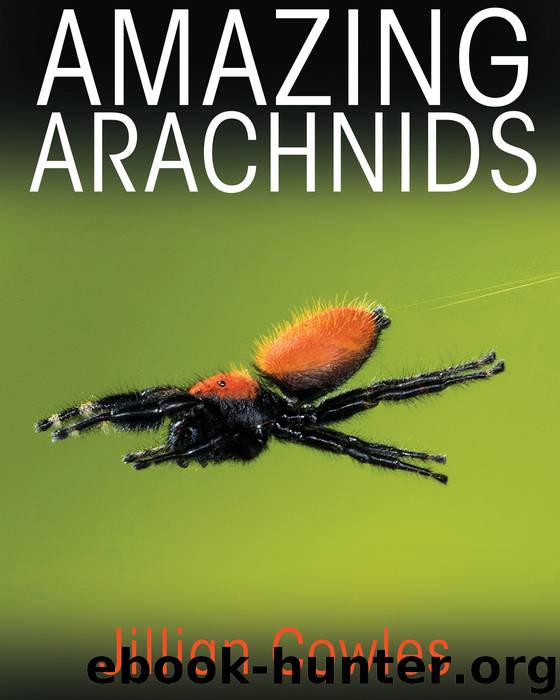Amazing Arachnids by Cowles Jillian

Author:Cowles, Jillian.
Language: eng
Format: epub
Publisher: Princeton University Press
Published: 2018-03-14T16:00:00+00:00
The male pholcid spider (Physocyclus) has tiny ridges on his chelicerae. During courtship, he rubs these ridges with a hardened area of his pedipalp, thus stridulating and so signaling to the female spider.
Micrograph of the cheliceral ridges.
During courtship and mating, spiders demonstrate a surprising variety of behaviors, from simple to incredibly elaborate. Some species of crab spiders (Thomisidae) have a minimalist approach in which the male simply climbs onto the female and, with virtually no preliminaries, proceeds to mate with her. Others, such as the black widow, send vibrational signals between the courting couple via the web silk. The male first plucks the female’s web. Then both the male and female vibrate their abdomens in turn, each answering the other until the male approaches the female and mates with her. The male desert blond tarantula, Aphonopelma chalcodes, initiates courtship by drumming his pedipalps on the ground near the female’s burrow entrance. If the female is receptive, she replies, also drumming her pedipalps on the substrate before climbing up out of her burrow to meet the male. The male must hold her body upright by hooking the tibial spurs of his first pair of legs under the female’s fangs in order to mate. In another example of the male holding the female’s fangs, long-jawed orb weavers (Tetragnathidae) interlock their enormously long chelicerae and fangs against each other while they mate. The male must have a long reach with his pedipalps in order to successfully mate while in this position. The visually oriented wandering hunters, such as the jumping spiders (Salticidae) and wolf spiders (Lycosidae), incorporate complex visual displays into their courtship. In many of these species, especially the jumping spiders, the males have conspicuous tufts of hair or bright colors and must perform a dance with specific leg-waving as well as drumming and vibrating the abdomen. The male nursery web spider Tinus (Pisauridae) presents the female with a gift of wrapped prey before mating. This may buy some time for the male to mate while the female feeds on the nuptial gift. In another version of buying time, the male sand spider (Homalonychus) wraps the female in a “bridal veil” of silk before mating. Although she can quickly extract herself from her bonds, it may give an alert male a chance to escape should she become aggressive. In some species, such as the redback spider of Australia, the male sacrifices himself during or immediately after mating; he actually does a back flip right into the female’s chelicerae. By providing nutrition to the female, he may increase the number of eggs she lays and therefore help to ensure that his own genes will be passed on. In other species, the male endeavors to escape immediately after mating, and is killed and eaten only if he is too slow. If he is quick enough to escape with his life, he may mate with other females. Finally, in some species, the males cohabit with the female after mating and even steal food from her web.
Download
This site does not store any files on its server. We only index and link to content provided by other sites. Please contact the content providers to delete copyright contents if any and email us, we'll remove relevant links or contents immediately.
| Cell Biology | Developmental Biology |
| Entomology | Marine Biology |
| Microbiology | Molecular Biology |
| Biostatistics |
Sapiens: A Brief History of Humankind by Yuval Noah Harari(13053)
The Tidewater Tales by John Barth(12030)
Do No Harm Stories of Life, Death and Brain Surgery by Henry Marsh(6336)
Mastermind: How to Think Like Sherlock Holmes by Maria Konnikova(6236)
The Thirst by Nesbo Jo(5785)
Why We Sleep: Unlocking the Power of Sleep and Dreams by Matthew Walker(5641)
Sapiens by Yuval Noah Harari(4537)
Life 3.0: Being Human in the Age of Artificial Intelligence by Tegmark Max(4507)
The Longevity Diet by Valter Longo(4445)
The Rules Do Not Apply by Ariel Levy(3906)
The Immortal Life of Henrietta Lacks by Rebecca Skloot(3826)
The Body: A Guide for Occupants by Bill Bryson(3801)
Why We Sleep by Matthew Walker(3772)
Animal Frequency by Melissa Alvarez(3755)
Yoga Anatomy by Kaminoff Leslie(3701)
Barron's AP Biology by Goldberg M.S. Deborah T(3632)
The Hacking of the American Mind by Robert H. Lustig(3580)
All Creatures Great and Small by James Herriot(3516)
Yoga Anatomy by Leslie Kaminoff & Amy Matthews(3395)
